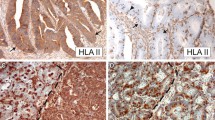Abstract
Employing blood group A− and A+ clones derived from the same parental colonic cancer cell lines, we studied the molecular mechanism of deletion/ reduction vs. continuous expression of A antigen in A tumors, a crucial determinant of human tumor malignancy. A− transferase mRNA level in one of the A− clones (A− SW480) was undetectable, while that in A+ SW480 was strongly detectable by semiquantitative RT-PCR. Relatively lower (∼1/3) transcript level was detectable in another A− clone (A− HT29) in comparison to A+ HT29 by the same RT-PCR procedure, although none of these tumor cell lines showed detectable level of A transcript by Northern blotting or RNase protection methods. Therefore, subsequent studies were performed employing A− vs. A+ SW480 clones. Deletion of A transcript in A− cells was not due to gene deletion, since Southern blot analysis showed equal presence of genomic DNA regardless of A− vs. A+ (SW480 or HT29) or B+ (KATOIII) tumor cells. Two transcriptional control mechanisms leading to differences of A expression in SW480 cells are indicated.
i. Luciferase assay in A− and A+ SW480 cells showed that promoter activities of segments of 5′ flanking sequence of ABO gene reflected transcript levels in these cell lines. The enhancing activity of a 43bp tandem repeat unit located between −3899 to −3618 was reduced in A− compared to A+ cells.
ii. Distinct differences in the pattern of CpG dinucleotide methylation were found in A− vs. A+ cells. Therefore, the methylation process of A promoter DNA may be another important factor controlling A activity in SW480 tumor cells.
Since proliferation and motility of tumor cells are associated closely with A expression, transcription control mechanism for expression of A transferase as described above may be of crucial importance in defining human tumor malignancy.
Similar content being viewed by others
References
Hakomori S (1984) Philip Levine Award Lecture: Blood group glycolipid antigens and their modifications as human cancer antigens. Am J Clin Pathol 82: 635–48.
Hakomori S (1996) Tumor malignancy defined by aberrant glycosylation and sphingo(glyco)lipid metabolism. Cancer Res 56: 5309–18.
Ørntoft TF, Meldgaard P, Pedersen B, Wolf H (1996) The blood group ABO gene transcript is down-regulated in human bladder umors and growth-stimulated urothelial cell lines. Cancer Res 56: 1031–36.
Ichikawa D, Handa K, Withers DA, Hakomori S (1997) Histoblood group A/B versus H status of human carcinoma cells as correlated with haptotactic cell motility: Approach with A and B gene transfection. Cancer Res 57: 3092–96.
Goupille C, Hallouin F, Meflah K, Le Pendu J (1997) Increase of rat colon carcinoma cell tumorigenicity by a(1–2)fucosyltransferase gene transfection. Glycobiology 7: 221–9.
Ichikawa D, Handa K, Hakomori S (1998) Histo-blood group A/B antigen deletion=reduction vs. continuous expression in human tumor cells as correlated with their malignancy. Int J Cancer 76: 284–9.
Kominato Y, Tsuchiya T, Hata N, Takizawa H, Yamamoto F (1997) Transcription of human ABO histo-blood group genes is dependent upon binding of transcription factor CBF/NF-Y to minisatellite sequence. J Biol Chem 272: 25890–8.
Sambrook J, Fritsch EF, Maniatis T (1989) Molecular cloning: A laboratory manual: Cold Spring Harbor Laboratory Press.
Clark SJ, Harrison J, Paul CL, Frommer M (1994) High sensitivity mapping of methylated cytosines. Nucleic Acid Res 22: 2990–7.
Herman J, Graff JR, Myohanen S, Nelkin BD, Baylin SB (1996) Methylation-specific PCR: A novel PCR assay for methylation status of CpG islands. Proc Natl Acad Sci USA 93: 9821–6.
Orita., Shimozaki K, Murakami H, Nagata S (1997) Binding of NF-Y transcription factor to one of the cis-elements in the myeloperoxidase gene promoter that responds to granulocyte colony-stimulating factor. J Biol Chem 272: 23216–23.
Bird AP (1986) CpG-rich islands and the function of DNA methylation. Nature 321: 209–13.
Liggett, WH, Sidransky D (1992) Role of the p16 tumor suppressor gene in cancer. J Clin Oncol 16: 1197–206.
Cooper DN (1992) Regulatory mutations and human genetic disease Ann Med 24: 427–37.
Macian F, Rao A (1999) Reciprocal modulatory interaction between human immunodeficiency virus type 1 Tat and transcription factor NFAT1. Mol Cell Biol 19: 3645–53.
Jones PA, Gonzalgo ML (1997) Altered DNA methylation and genome instability: A new pathway to cancer? Proc Natl Acad Sci USA 94: 2103–5.
Saunders NA, Dicker AJ, Jones SJ, Dahler AL (1998) E2F1 messenger RNA is destabilized in response to a growth inhibitor in normal human keratinocytes but not in a squamous carcinoma cell line Cancer Res 58: 1646–9.
Mahoney CW, Shuman J, McKnight SL, Chen H-C, Huang K-P (1992) Phosphorylation of CCAAT-enhancer binding protein by protein kinase C attenuates site-selective DNA binding. J Biol Chem 267: 19396–403.
Trautwein C, Caelles C, van der Geer P, Hunter T, Karin M, Chojkier M (1993) Transactivation by NF-IL6/LAP is enhanced by phosphorylation of its activation domain. Nature 364: 544–7.
Counts JL, Goodman, JI (1995) Alterations in DNA methylation may play a variety of roles in carcinogenesis. Cell 83: 13–15.
Hsieh C (1994) Dependence of transcriptional repression on CpG methylation density. Mol Cell Biol 14: 5487–94.
Author information
Authors and Affiliations
Rights and permissions
About this article
Cite this article
Iwamoto, S., Withers, D.A., Handa, K. et al. Deletion of A-antigen in a human cancer cell line is associated with reduced promoter activity of CBF/NF-Y binding region, and possibly with enhanced DNA methylation of A transferase promoter. Glycoconj J 16, 659–666 (1999). https://doi.org/10.1023/A:1007085202379
Issue Date:
DOI: https://doi.org/10.1023/A:1007085202379




